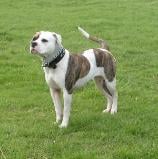
This is a placeholder text
Group text
by Kaffirdog on 02 March 2015 - 15:03
I'd guess this is old debate as to whether Trials should replace the Scale with an A frame. A normal dog should have no trouble getting to the top of a 6 ft scale, the most likely point of injury is when it comes down and that is why my Scale jump has a landing platform. I personally would not want to subject my dog to the joint stress and injury potential of the landing for a sport. As for the long jump, it is one of many exercises that have disappeared from the Schutzhund program along with the 11 hides in Schutzhund 1 and the crawl. The landing from a long jump is supposed to be very hard on the joints, but if the dog was not expected to stop and assume a position as soon as it landed, it would probably be less stressfull, I've never heard of anyone in Agility, where the dog keeps going after it lands, finding the long jumps a problem. I suspect it is more down to slimming down the program to save time at a trial than anything else
Margaret N-J
by Blitzen on 02 March 2015 - 15:03
Are there any real stats on health issues experienced by sport or working dogs that are subjected to frequent training and competition? I have always wondered how hitting the sleeve alone will effect a dog's neck and back. The jumps and A frames might be other concerns.
I am interested in reading about actual experience, not some anecdotal comments by someone who has never owned a competition dog or a dog that works in an extreme job 24/7. Not talking about a dog that has been shown just enough to earn titles and then not challenged again.
by Hired Dog on 02 March 2015 - 15:03
Blitzen, as far as bite work, IF, HUGE IF, the helper knows what they are doing and can take a proper hit, the dog is fine. Its the ones that have no idea that can hurt a dog very badly which is why I have always said that unless I see someone working multiple dogs, they are not going near my dog for a bite. There are dogs, the Malinois in the KNPV are one example, that hit VERY hard and cover a long distance, building up speed as they run and by the time they hit the helper at a trial, they are doing 30MPH....that can cause spine and neck issues, yes.
As far as joint issues, I know several Federal agencies that used trucks, F-150's as well as explorers and expeditions and had the dog jump out of the truck 10-15 times a day for work, that, over time, can cause shoulder problems which is why smart agencies will use sedans for K9 or a low truck to allow a dog better exit.
When it comes to jumps and such, me, personally, I dont do them. I will test a dog to see if it can and is willing to go over a 6 foot wall or a 4 foot fence, but, once I know it will, its done. I do not like teaching dogs ways to escape from their yard and making them capable of doing it.
by Hundmutter on 02 March 2015 - 16:03
Strewth, maybe VK and Kaffirdog have hit on the reasons for the variation.
There is no one authority, so there is no one 'leader' in deciding which
type of jumps to use, how high (or long) they should be. Some of the things
the SV has decided to drop - and the thinking there may be about strain on
the dogs, but that might as easily be anecdotal rather than empirical ; it could
indeed also be about time constraints on exercises - have been picked up & changed
in IPO in the UK and Europe, and to some extent America and elsewhere, on a
"where Germany leads, others follow" basis, perhaps without too much thought going
into why the preference occurred; and then again, others running 'competitions', eg
UK KC WT, or KNPV, haven't followed along - because they see no need to change
tried and tested exercises they are used to / like. + The UK WT Rules have to be acceptable
to a wider spread of breeds & sizes of dogs, perhaps, than those trials aimed primarily at
the medium to large 'working' breeds, eg various Shepherds / Rotties / Boxers &c.
Contact information Disclaimer Privacy Statement Copyright Information Terms of Service Cookie policy ↑ Back to top





